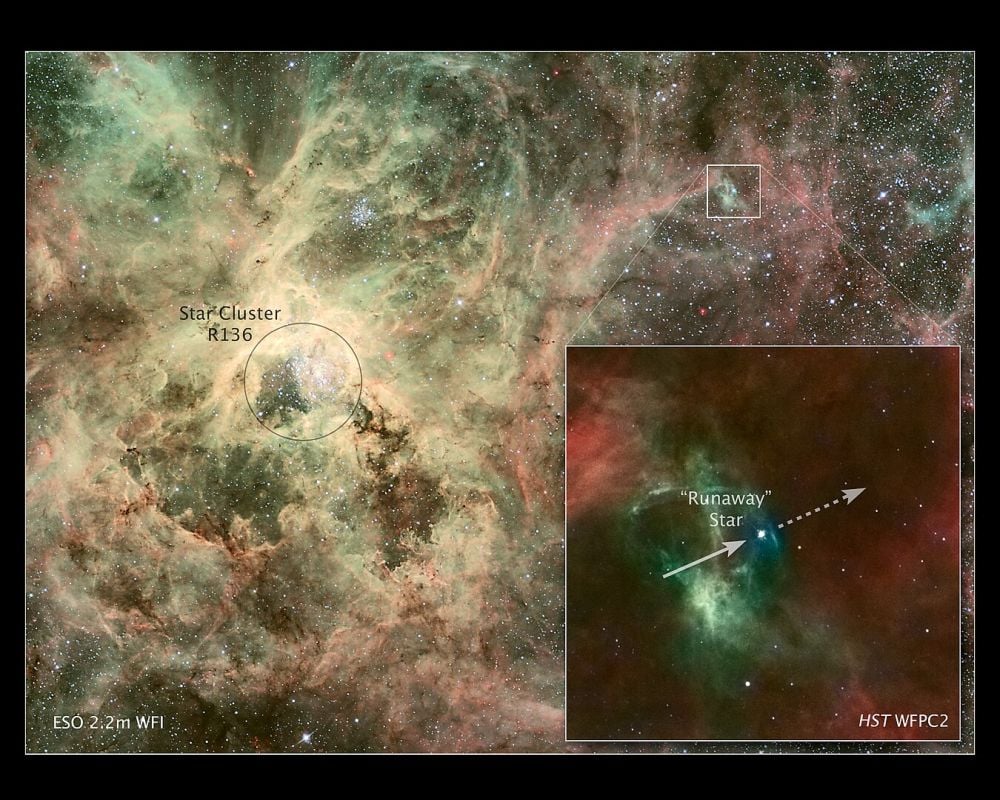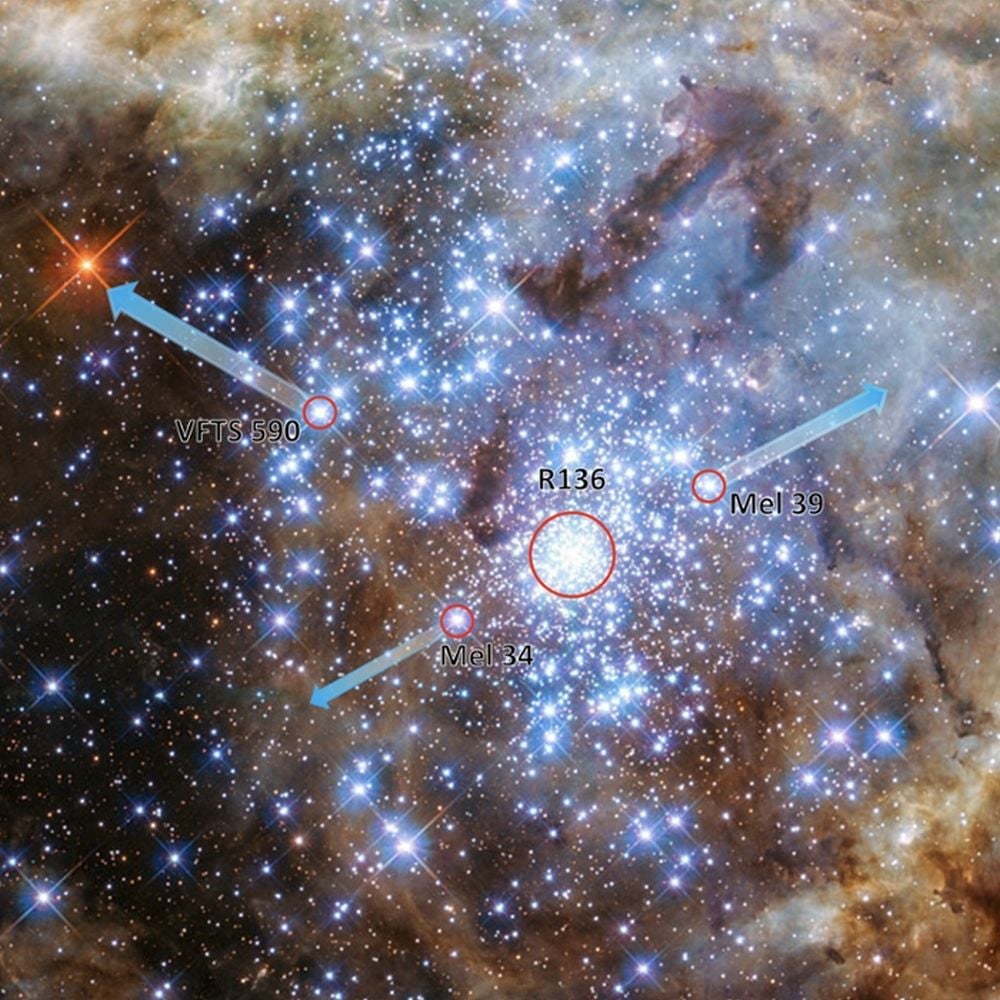Stars are born in clusters, and the early days in these clusters are messy. Stars move chaotically and haven’t settled into regular routines. Inevitably, some stars are kicked out of their birth clusters through all of the gravitational interactions.
The Large Magellanic Cloud, though much less massive than the Milky Way, is home to a very unusual star cluster named NGC 2070. NGC 2070 is a large open star cluster within the Tarantula Nebula in the LMC. NGC 2070’s central cluster makes astronomers sit up and take notice. It’s called R136, and it holds an extremely dense concentration of massive O-type stars and Wolf-Rayet stars. O-type stars are very hot, and very rare, but since they’re so luminous they’re not difficult to spot. Wolf-Rayet stars are also massive, hot, and highly luminous.
The extraordinary luminosity of the stars in R136, which altogether have about 60,000 solar masses, provides most of the energy that illuminates the entire Tarantula Nebula. For this reason, it’s called a starburst region. It contains many of the most massive and luminous stars astronomers know of.
This JWST image of the Tarantula Nebula highlights the brilliant central cluster R136. This tightly-packed region of extremely luminous stars lights up the nebula. Image Credit: NASA, ESA, CSA, STScI, Webb ERO Production Team
R136 is very young, only about one or two million years old. The region is extremely chaotic, and in 2024, astronomers found 55 massive runaway stars coming from the cluster in two waves. A 2024 paper reporting these findings also discovered that 23–33% of the most luminous stars initially born in R136 are runaways.
New research published in Physical Review Letters examined what’s behind some of these stellar ejections, focusing on a binary star named Mel 34. It’s titled “Origin of the Most Recently Ejected OB Runaway Star from the R136 Cluster.” The lead author is Simon Portegies Zwart, Professor of Numerical Star Dynamics at Leiden University in the Netherlands.
The 2024 paper used data from the ESA’s Gaia mission to show that three of R136’s ejected stars were evicted from the core about 60,000 years ago. However, what caused the triple ejection was unknown. In the new research, Portegies Zwart and his co-researchers reconstructed their ejection, showing that there were five stars involved in the expulsion.
Mel 39 is a binary star with two massive stars, one with 140 solar masses, and the other with 80. Mel 39 is travelling away from the R136 cluster at 64 km/s. It’s in the same orbital plane as Mel 34, the other ejected binary. Mel 34 is one of the most massive known binaries, with the larger of the pair having 139 solar masses, and the other one with 127 solar masses. When combined with VFTS 590, the other star involved, and its 46 solar masses, the five stars constitute more than 530 solar masses.
The researchers relied on Gaia’s precise astrometry to untangle the backstory of these five stars and their ejection from R136. Mel 34 was the last of the stars to be ejected, and tracing it backwards in time and space helped the researchers reconstruct the interactions that led up to the ejection.
“Because of the Gaia satellite’s outstanding precision, we can now retrace the most recently ejected binary star, Mel 34, back to the center of R136 and reconstruct the events that 52 000 years ago led to its removal from R136,” the authors write. “The deterministic nature of the Newtonian dynamics in the scattering enables us to reconstruct the encounter that ejected Mel 34.”
Gravitational interactions follow Newton’s laws of motion, which are deterministic. That means the same starting conditions always produce the same results, unlike quantum laws. So by measuring Mel 34’s trajectory, position, and velocity, the researchers ‘mathematically reversed’ Mel 34’s path, and recovered a picture of the expulsion of the stars. In a sense, each star is like a fossil record of its origins that allows backwards tracing.
 Runaway stars stand out from the background due to their trajectories and velocities. In 2010, the Hubble Space Telescope found another star ejected from a different part of the Tarantula Nebula. The heavyweight star, called 30 Dor #016, is 90 times more massive than the Sun and is travelling at more than 400,000 kilometers per hour from its home. Image Credit: By NASA, ESA, J. Walsh (ST-ECF) Acknowledgment: Z. Levay (STScI) Credit for ESO image: ESO Acknowledgments: J. Alves (Calar Alto, Spain), B. Vandame, and Y. Beletski (ESO) Processing by B. Fosbury (ST-ECF) – http://www.spacetelescope.org/news/heic1008/, CC BY 3.0.
Runaway stars stand out from the background due to their trajectories and velocities. In 2010, the Hubble Space Telescope found another star ejected from a different part of the Tarantula Nebula. The heavyweight star, called 30 Dor #016, is 90 times more massive than the Sun and is travelling at more than 400,000 kilometers per hour from its home. Image Credit: By NASA, ESA, J. Walsh (ST-ECF) Acknowledgment: Z. Levay (STScI) Credit for ESO image: ESO Acknowledgments: J. Alves (Calar Alto, Spain), B. Vandame, and Y. Beletski (ESO) Processing by B. Fosbury (ST-ECF) – http://www.spacetelescope.org/news/heic1008/, CC BY 3.0.
“We then predict that Mel 39 is a binary star with an 80𝑀⊙ companion star that orbits within ∼1° in the same plane as Mel 34 and escapes the cluster with a velocity of ∼64 km/s,” the authors explain.
The reconstruction simulations show that the ejection involved five stars, the Mel 34 and Mel 39 binaries and VFTS 590. Since two are binaries, the system acts like a triple star, where VFTS 590 and Mel 34 orbit Mel 39. These results were unexpected, according to the authors. “The participation of five stars is unexpected because runaway stars were not expected to result from triple interactions,” they explain in their paper.
These stars are travelling rapidly away from R136 due to the interactions, but there fates are sealed. All five of these massive stars will eventually explode as supernovae in a few million years. “The five stars will undergo supernova explosions in the coming 5 Myr at a distance of ∼180–332 pc from their birth location (R136),” the researchers explain in their paper.
“The resulting black hole binaries, however, are not expected to merge within a Hubble time,” they conclude.
The ejected stars in this study aren’t R136’s only runaway stars. Its 55 runaway stars paint a picture of R136 as an extreme, dynamically active region. With all of these ejected stars, many of them extremely bright, the star cluster is an excellent natural laboratory to study how massive clusters like this one evolve.
